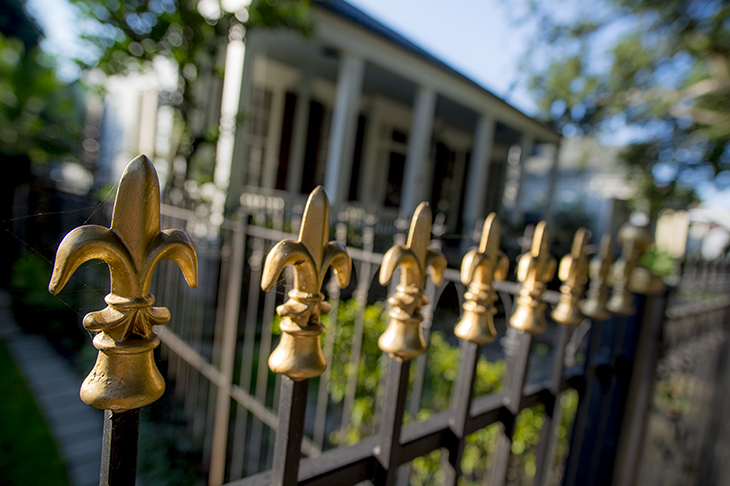Include a Topper!
-
Happy Birthday Banner
$9.00
Add Ons
Your cart is currently empty!
Since 1949 celebrating 75 years. Order online or call us at 1 800 GAMBINO (426-2466)


It’s no secret that New Orleans is rife with the symbol of the fleur-de-lis, adorning wrought iron fences around the city, present on almost every tourist souvenir, and of course emblazoned on Saints helmets. But its history is more convoluted than w
e often care to acknowledge. The fleur-de-lis (sometimes spelled fleur-de-lys) has associations reaching across the globe, from ancient Egypt and
Babylonia, to the Roman Catholic church and the French monarchy. Its representations have transformed over time, spanning from a symbol of purification and luxury to one of slavery and punishment. In order to truly understand the place the fleur-de-lis holds in New Orleans culture, we must first understand where it came from.
Ancient Beginnings: The Fleur-de-Lis in the Early Ages
Today we recognize the fleur-de-lis as a stylized depiction of a lily flower or iris: three petals bound together in their center. It may surprise you to know, however, that the fleur-de-lis’ shape didn’t always represent a flower. In ancient Egypt, the symbol for the asp, the venomous snake who delivered Cleopatra’s fatal bite, actually greatly mirrored the shape of the fleur-de-lis and is considered to be an early prototype. The fleur-de-lis also has predecessors in ancient Mesopotamia, Babylonia, Greece, and even in Rome. The fleur-de-lis of Rome actually came to represent fidelity and unity among the people.
The Fleur-de-Lis and the Catholic Church
Taking our symbol a couple centuries forward in time, we can look at its development within the Roman Catholic tradition. In the third century King Clovis I was crowned King of the Franks. He was a member of the Merovingian dynasty and considered to be the founder of France. Two legends surrounded Clovis’ connection to the fleur-de-lis; the first legend brought the fleur-de-lis into Catholic symbology, and the second legend (which we will discuss later) created ties between the fleur-de-lis and the French monarchy.
Sticking with the first legend, Clovis was originally born pagan. It wasn’t until closer to his coronation that he decided to convert to Christianity in order to gain a larger following from his subjects. It is said that upon his baptism an angel in the form of a dove brought Clovis a golden lily that was born of the tears Eve shed as she left Eden. This lily was meant to represent Clovis’ purification and thus became a symbol of cleansing in the Catholic tradition. The Catholic church continued to use the fleur-de-lis over time, employing it both as a representation of the Virgin Mary as well as the Holy Trinity (each of the symbol’s petals standing for one of the trinity’s three). The symbol was displayed often in conjunction with plights of the church. For example, Joan of Arc lead the French troops into battle against the English carrying a banner with the fleur-de-lis emblazoned on it. And later in 800 CE Pope Leo III used a banner adorned in fleur-de-lis during his coronation of Charlemagne as emperor to signify the unity of the church and the government.
The French Fleur-de-Lis
The second legend surrounding King Clovis’ adoption of the fleur-de-lis speaks more toward its synonymousness with the French monarchy. The legend says that Clovis encountered a river on his way to battle and waterlilies formed a path that allowed him to cross the river safely and thus succeed in his crusade. Through this legend the fleur-de-lis came to symbolize life, perfection, and light. Clovis’ use of the fleur-de-lis as a symbol of his successful reign carried on throughout the years, but was adopted officially by the French monarchy in the twelfth century. At that time King Louis VI emblazoned the symbol upon his shield, used it in his signet ring, and created the azure-semé-de-lis (the French heraldic blazon featuring fleur-de-lis on a expansive background of blue). The connection between the fleur-de-lis and the French monarchy became universally known. For centuries the English actually employed the symbol as a way to demonstrate a British claim on the French throne, sewing the design onto their knights’ chainmail.
The Florentine Fleur-de-Lis
Of course, the French aren’t the only ones who lay claim upon the fleur-de-lis. The symbol also has prominence in Italian culture. The fleur-de-lis is actually the official emblem of Florence, having been made so in the early eleventh century (beating France by several decades). In Florence the fleur-de-lis is depicted as a red lily upon a white background, a color scheme that was once reversed. During the German rule of Florence in the 1200’s the lily was actually colored in white while the background was red. It was switched once Florentine people prevailed over the Germans in order to exemplify their victory. Their emblem does, however, differ slightly from the fleur-de-lis we usually recognize here in New Orleans. Where our fleur-de-lis represents only the three petals of the flower, the Florentine fleur-de-lis depicts two decorative stamen between each petal.
Where Does New Orleans Come In?
Of course, with a city as rich in French culture as New Orleans, it’s not hard to guess how the fleur-de-lis became such a local symbol. The fleur-de-lis was a symbol of our land from its first discovery. In 1682 when French explorer Sieur de la Salle first claimed the Mississippi Valley for King Louis XVI (Louisiana being a derivative of Louis’ name), he planted into the soil a flag adorned in fleur-de-lis. Only a couple decades later in 1718 French settlers founded La Nouvelle Orléans (for those of you who don’t speak French, that’s New Orleans), flying a fleur-de-lis flag to honor the French monarchy’s ties to Orléans.
Our culture has taken the symbol on in spades, though not always for the better. Due to its connection with the French monarchy, New Orleanians came to understand the fleur-de-lis as a representation of power and it is through this interpretation that the symbol became related to slavery. In the eighteenth and nineteenth century white Americans used the fleur-de-lis to exert power over slaves, branding the symbol into the right shoulder of those who had attempted to run away. A dark and upsetting correlation with “code noir,” the fleur-de-lis was used to scar slaves and mark them as troublemakers within the community.
What Does the Fleur-de-Lis Mean Today?
With such a transformative reputation, it is hard to pin down the meaning of the contemporary New Orleans fleur-de-lis. We have come to separate ourselves from the French monarchy and our Holy Trinity revolves less around the church than it does the Holy Trinity of Louisiana cooking: green pepper, onions, and celery. Despite all this, I think it’s safe to say that New Orleans has taken on the fleur-de-lis as a symbol of unity and cultural pride.